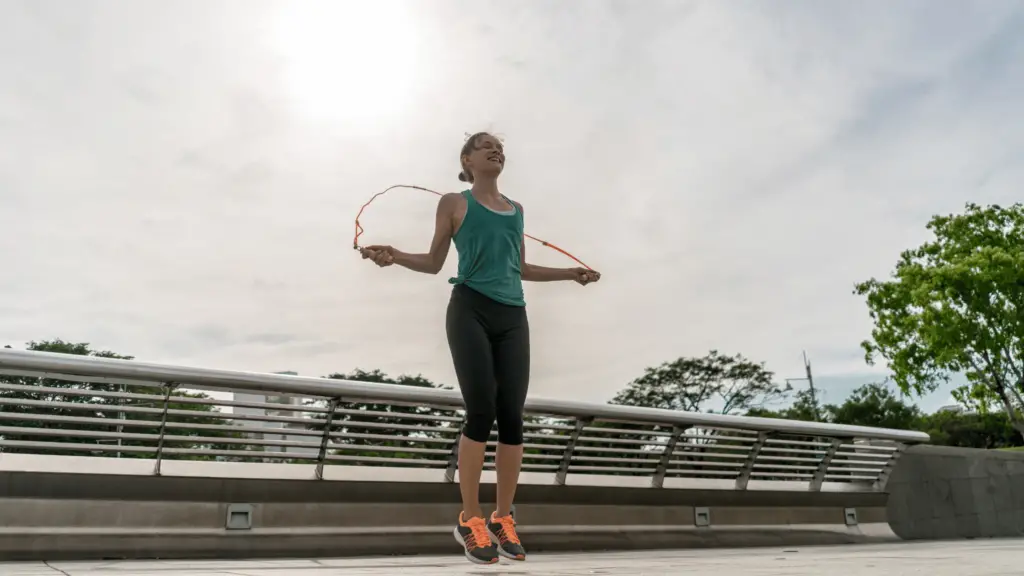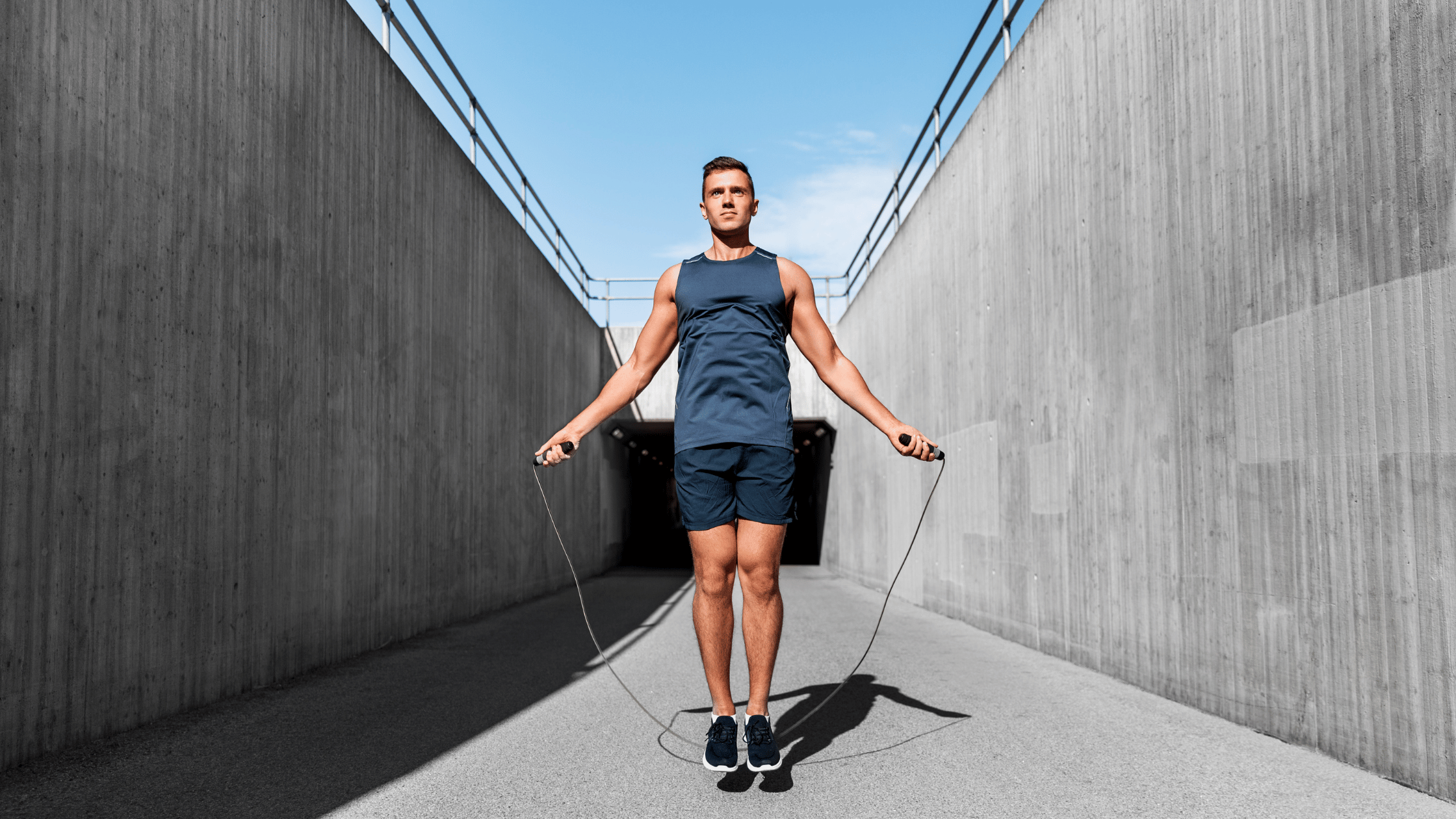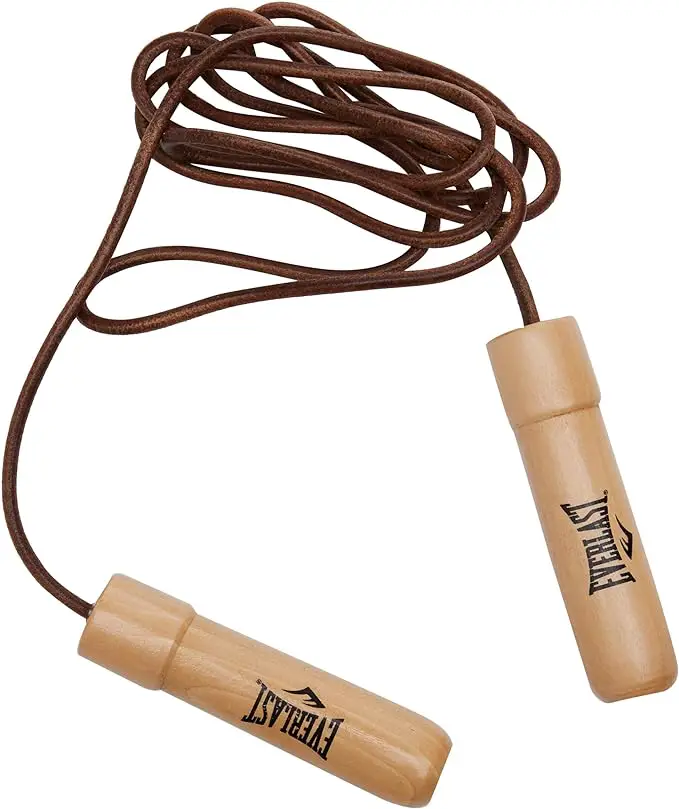Jump roping is a fun and inexpensive way to get started on your fitness journey and also a great hobby.
As a beginner, you may be overwhelmed by the numerous techniques, rope types, and workout routines available.
In this guide, we will break down the basics of jump roping as a hobby, ensuring that you start on the right foot and build a strong foundation for your new hobby.

Beginning with selecting the appropriate jump rope, you will discover how to correctly size it to your height, the types of ropes available, and which ones serve your specific goals.
You will also be introduced to essential jump-roping techniques that form the backbone of any routine, allowing you to develop the necessary skills and fitness level.
In addition to learning the techniques, it is crucial to establish a routine that supports your progress. We will provide guidance on designing an effective workout plan tailored to your needs, as well as tips for staying motivated and avoiding common jump-roping injuries.
With this guide, you will feel confident and knowledgeable as you embark on your jump-roping journey.
Understanding Jump Roping

Jump roping is a fun and accessible hobby for beginners looking to improve their overall fitness and coordination. This activity is an excellent way to burn calories, enhance cardiovascular health, and build endurance. In this section, we will discuss the basics of jump roping and how you can make the most out of this enjoyable exercise.
To begin with, choosing the right jump rope that suits your skill level and preferences is essential. Look for one with a comfortable grip and an adjustable length to tailor it according to your height. The ideal rope length should have the handles reach approximately your arm’s midsection when the rope is under your feet.
Mastering the proper form is crucial for enjoying a safe and efficient jump roping experience. Start by standing upright and positioning the rope under your feet, with both hands evenly spaced at waist-level. Keep your elbows in and avoid excessive arm movement while rotating the rope. Use your wrists to maintain a smooth and controlled motion.
Incorporate a consistent jumping pace to engage your core muscles and maintain balance. Starting with a basic bounce, where you hop a few inches off the ground, is a good approach for beginners. As you get comfortable with the movement, consider experimenting with different skipping styles, such as the boxer’s step or double unders, to keep things interesting.
Lastly, don’t forget the importance of practice. Regularly dedicating time to your jump roping routine will help improve your coordination, rhythm, and overall performance. Ideally, aim for shorter sessions initially and gradually increase the duration as your endurance and capabilities grow. Remember to always listen to your body and adjust the intensity accordingly.
By understanding the fundamentals of jump roping, you can enjoy this exciting hobby while reaping its numerous health benefits. Keep it fun, stay consistent, and watch your skills transform over time.
Benefits of Jump Roping

Jump roping is a fun and effective way for you to improve your fitness levels and achieve various physical benefits. As a beginner, you might not realize the full extent of the advantages that come with incorporating jump roping into your workout routine.
One of the most sought-after benefits of jump roping is weight loss. This high-intensity workout helps you burn calories quickly, making it an efficient method to shed excess pounds. For instance, it’s possible to burn around 200 calories in just 15 minutes of continuous jump roping.
In addition to weight loss, jump roping provides an excellent cardio workout. As you increase your heart rate, you enhance your cardiovascular health, which in turn can help prevent numerous heart-related issues. Moreover, the high-intensity nature of jump roping aids in building endurance over time, allowing you to get leaner and perform other physical activities more efficiently.
Jump roping also helps improve your balance and posture. The habit of maintaining proper body alignment while jumping rope can translate to better posture in everyday life. As you practice, you’ll notice improved balance, which can benefit you in other sports and physical activities.
When it comes to bone density, jump roping can be a valuable asset. The regular impact of jumping can contribute to strengthening your bones, reducing the risk of developing osteoporosis later in life.
Lastly, jump roping can be easily incorporated into a HIIT (High-Intensity Interval Training) routine. By integrating short bursts of intense jump roping with recovery periods, you’ll not only burn calories but also boost your overall fitness levels.
Incorporating jump roping into your hobby or workout routine can provide you with numerous physical benefits, making it an excellent activity for beginners and advanced athletes alike.
Choosing Your Equipment

When starting your jump roping journey, selecting the right equipment is crucial. First and foremost, you need to choose the appropriate jump rope. There are several types to consider, including weighted jump ropes and those made from different materials.
Weighted jump ropes provide extra resistance, helping you build strength and endurance. They can be an excellent choice if your primary goal is to build muscle in addition to improving your cardiovascular fitness. Weighted ropes typically fall into two categories: those with weighted handles and those with a weighted rope.
Start with a standard get lean set to ease your way into jump roping. This type of jump rope focuses on speed and agility, allowing you to progress at your own pace. As you gain experience and confidence, you can advance to a weighted rope.
Material plays a significant role in the performance and durability of your jump rope. Common materials include PVC and leather. PVC ropes are lightweight and tend to be the most budget-friendly option.
Meanwhile, leather jump ropes provide a more traditional feel and usually last longer.
Length is another essential consideration. To find the right size, stand on the middle of the rope and pull the handles upwards. They should reach your armpits. If the rope is too long or too short, it can affect your jump roping experience and performance.
Additionally, investing in a jump rope mat can protect both your rope and the surface you are jumping on. It also reduces noise and offers more cushioning for your joints.
Basic Techniques and Skills

When starting your jump rope journey, it’s essential to learn the basic techniques and skills. In this section, you’ll find information on how to master the foundation of jump roping exercises, so you can progress confidently and effectively.
One of the fundamental techniques to grasp in jump roping is the basic jump. Remember to maintain proper posture by standing tall, tucking in your core, and keeping your head straight. Hold your jump rope handles with a firm grip and keep your elbows close to your body. Start with the rope behind your heels and swing it over your head. Jump with both feet together just a few inches off the ground, and avoid jumping too high.
To excel in jump roping, it’s crucial to develop good coordination. A strong mind-body connection will help you better control your movements and maintain rhythm. To improve your timing and precision, practice jumping at a steady pace while focusing on your breath. As you gain experience, try to increase your speed and vary your footwork patterns.
Footwork is a significant aspect of jump roping that cannot be overlooked. Some of the most common footwork techniques include the basic bounce, alternating feet, and high knees. Mastering these footwork patterns will improve your agility and overall jump rope efficiency. Be patient while learning different footwork techniques, and take time to practice each movement separately before combining them.
Proper technique is vital in any sport, and jump roping is no exception. Avoid common mistakes, such as jumping too high or extending your arms too far away from your body. Always maintain a neutral spine and relaxed shoulders, as tension can negatively impact your performance. To ensure you’re using the correct form, consider recording yourself or asking a knowledgeable friend for feedback.
In addition to technique, incorporating various jump rope exercises can enhance your overall performance. Some popular exercises include the double under, criss-cross, and side-to-side jumps. These exercises not only provide a robust cardiovascular workout but also help develop agility, balance, and mental focus.
In conclusion, mastering the basic techniques and skills of jump roping will set you up for success in this exciting hobby. With practice, patience, and a focus on proper form, you’ll quickly see improvements in your coordination, footwork, and agility. Happy jumping!
Creating Your Workout Routine

When starting your jump rope journey, it’s essential to create a workout routine tailored to your fitness level. To begin, ensure you’ve selected the appropriate jump rope and adjust it to your height. Then, follow these steps to establish a balanced training regimen.
Firstly, warm up for 5-10 minutes with light exercises like jumping jacks or dynamic stretches. Warming up your muscles will help prevent injuries and improve your overall jump rope performance.
Next, incorporate jump rope cardio sessions into your routine. Start with a beginner jump rope workout of 30-45 seconds of jumping followed by a 30-second rest. As your stamina improves, increase the duration and intensity of jump rope workouts. Tabata exercises, which consist of 20 seconds of high-intensity work followed by 10 seconds of rest for eight rounds, are excellent for honing your cardiovascular endurance.
Don’t forget to include full-body workouts for strength training and muscle development. Supplement your jump rope routine with exercises like push-ups, squats, and planks to target primary muscle groups. Aim for 2-3 sets of 10-15 repetitions for each exercise, depending on your fitness level.
Finally, after every workout, remember to cool down. Stretching and performing slow, controlled movements for about 5-10 minutes will help your muscles recover and reduce soreness.
Determine the frequency of your workouts based on your lifestyle and fitness goals. Beginners should aim for 3-4 jump rope sessions per week, gradually increasing the number as they become more experienced. Keep in mind that rest and recovery are crucial to progress, so make sure to listen to your body and adjust your routine as needed. Happy jumping!
Avoiding Common Mistakes

Jump roping can be a fun and rewarding hobby, but it’s important to avoid common mistakes that can lead to injuries or hinder your progress. In this section, we will discuss some of the most common mistakes and how you can avoid them in order to improve your technique and stay safe while practicing.
One common mistake is using improper footwear. Make sure to wear supportive, non-slip shoes that provide adequate cushioning for your feet. This will help prevent injuries and ensure that you can jump rope comfortably.
Another mistake to watch for is jumping too high. This not only wastes energy but can also cause strain on your joints. To avoid this, maintain a low, controlled jump—just enough to clear the rope.
To minimize common mistakes, it’s essential to maintain a good posture. Keep your head up, chest forward, and shoulders relaxed. Your elbows should be close to your sides, with your hands at waist height. Moreover, your wrists should do most of the work to spin the rope, rather than relying on arm movements.
Proper rope length is crucial. When you stand on the middle of the rope, its handles should reach your armpits. Using a rope that’s too long or too short could affect your coordination and cause tripping or tangling.
Make sure to take breaks and prioritize rest days as well. Overworking yourself can lead to fatigue, which increases the likelihood of making mistakes and sustaining injuries. Remember to listen to your body and avoid pushing yourself too hard.
Finally, consider seeking feedback from others, such as a friend or a jump rope coach. This can help you identify any mistakes you might not be aware of and provide guidance on how to correct them.
By avoiding these common mistakes and adhering to proper technique, you’ll be well on your way to mastering jump roping as a hobby while minimizing any risk of injury.
Using the Crossrope App

The Crossrope app is a fantastic tool to help you achieve your fitness goals while enjoying the hobby of jump roping. As a beginner, it can assist you in making the most out of your jump rope workouts.
To get started with the Crossrope app, download it from the App Store or Google Play Store on your smartphone. Once installed, create your account and pair your Crossrope jump rope, if you have a smart rope, to track your progress seamlessly. If not, don’t worry; you can still utilize the app’s features with any regular jump rope.
The app offers a variety of workout plans and challenges, specifically tailored to your fitness level and goals. As a beginner, you will find workouts designed to help you improve your jump rope skills, increase your endurance, and build strength in a step-by-step manner. The workouts range from short, focused sessions to full-length, comprehensive workouts. You can choose the duration, difficulty, and type of workout that suits your schedule and needs.
Some highlights of the Crossrope app include:
- Personalized workout plans
- Easy-to-follow video tutorials to master jump rope techniques
- Progress tracking and workout history
- Built-in interval timer for structured workouts
- Access to a supportive community of fellow jump rope enthusiasts
Make sure to take advantage of the Crossrope app as you embark on your jump roping journey. It provides a solid foundation for you to develop proper techniques, stay motivated, and achieve your fitness goals, all while enjoying the benefits of this versatile hobby.
Frequently Asked Questions

What are the basic techniques for jump roping?
To start jump roping, you need to master a few basic techniques. First, hold the handles of the rope loosely in your hands, with your elbows close to your body.
Start with a basic bounce, where you jump with both feet simultaneously, maintaining a comfortable rhythm. As you become more comfortable, you can experiment with alternate foot jumping, double unders, and crossovers.
How often should a beginner practice jump roping?
As a beginner, it’s important to build consistency and endurance. Start by jump roping for short sessions of 5-10 minutes, 3-4 times a week. Gradually increase the duration and frequency as you become more comfortable and confident in your abilities.
What type of jump rope is best for beginners?
A basic beaded or PVC rope is ideal for beginners. These ropes tend to be more affordable, durable, and easier to control compared to speed ropes. As you progress, you can explore different types of ropes, including weighted, speed, and leather ropes based on your preferences and goals.
How long should each jump rope session last?
Initially, aim for short sessions of 5-10 minutes to help your body acclimate to the activity. As you improve, you can increase your session duration to 20-30 minutes, incorporating rest periods and various routines to keep your workouts engaging. Remember, it’s crucial to listen to your body and progress at your own pace.
What are some common mistakes to avoid when starting?
Some common mistakes to avoid include:
- Jumping too high: Aim for small, controlled jumps with both feet barely leaving the ground.
- Excessive arm movement: Keep your arms relaxed and rely on your wrists to control the rope’s movement.
- Improper rope length: Ensure the rope is an appropriate length by stepping on its center and checking that the handles reach your armpits.
By avoiding these mistakes, you’ll be able to learn the correct form and build good habits.
How can one track progress in jump roping?
Tracking your progress in jump roping can be achieved through various methods:
- Use a timer or app to track the duration of your sessions.
- Count the number of consecutive jumps you can perform without getting tangled in the rope.
- Track the frequency and consistency of your workouts in a journal.
Remember, progress can be slow initially, but with patience and practice, your skills will improve over time.


